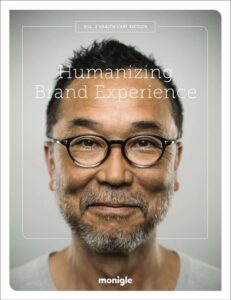Leading with Brand: Part 1

3 Ways Brand & Marketing Can Create More Human Health Care Experiences
At Monigle, we talk a lot about improving health care experiences for consumers. But what does that really entail? And what can we, as brand and marketing leaders, actually do to make an impact?
After years of research with consumers, we’ve identified the biggest challenges getting in the way of great health care experiences. From long wait-times and rushed appointments to complicated billing and lack of cost transparency, the health care industry has no shortage of experience issues to address—and the truth is there’s no quick fix. It will take large investments of time, money and resources to solve these problems. And to further complicate the challenge, many of the structural changes that need to happen lie outside the domain of marketing and brand teams.
But that doesn’t mean there’s nothing we can do. In fact, we have an opportunity to become the consumer’s biggest advocates. We can use our insight to pinpoint where change is needed. And, we can use strategic efforts to make a meaningful difference at the touchpoints and journey-steps that are most important.

Based on a multiple-year, comprehensive research study with more than 18,000 health care consumers in 33 markets across the country, we’ve identified the top two experience improvements that patients are crying out for—and we’ve outlined the brand-first solutions you can implement to start making a difference. Today, we’ll focus on the first improvement: making health care more human.
Improvement 1: Implement brand and experience strategies that make health care feel more personal, patient-centric and human
|
If you’ve read our Humanizing Brand Experience report, you know that finding ways to infuse health care with more humanity and personalization is key to improving the experience. Across the board, consumers believe that health care providers and organizations often lack the personal connection they crave. For many, this lack of personalization is attributed to the following pain points:
-
- Perceived lack of compassion and empathy
- Long waits and rushed appointments
- Desire for more individualized attention and care

Learn more: from our Humanizing Brand Experience Vol 2 Report
It’s true that some of these problems are structural: brand and marketing teams can’t control how many appointments are on the schedule each day and can’t always prevent the internal upsets that lead to long wait times. However, at their core, these issues boil down to patients feeling like their time isn’t valued, and that they’re being treated like a number, not a person. And those are emotional, human needs that we can address.
In fact, here are three strategies that brand and marketing teams can implement to create a more personal experience for patients:
1.The challenge: Perceived lack of compassion and empathyThe brand solution: Create a culture that values emotional outcomes as much as medical ones
|
“I think what is missing is good customer service. It is so frustrating when you approach a window and there is no eye contact, no smile, no greeting. Customer service should be the first thing this workforce needs classes on.” – Female health care consumer, Southern U.S.
Many of today’s consumers share a sense that health care providers and employees lack the compassion, empathy and customer-service that they want from their experience. They crave a personal relationship that feels attentive towards their emotional state and needs—but often their lived experience fails to measure up.
Brand teams can take the lead on addressing this gap by acting as both a rallying cry and a reminder of the importance of each individual employee’s role in delivering exceptional, patient-centric experiences. Brand-led training sessions that highlight service principles are key to showing people how to live the brand in their day-to-day—and why it’s so important that they do so. The goal for brand initiatives should be to establish a culture focused on the emotional, human experiences that are important to patients.
Healthcare organizations across the country are working to deliver more human brand experiences, starting with culture. For example, Holy Redeemer Health System—along with an innovative redesign of their space to foster a restorative internal culture—has implemented unique recruitment strategies to ensure all new hires are not only qualified, but also a good culture fit for the organization and brand.
2.The challenge: Long waits and rushed appointmentsThe brand solution: Give control back to the patient by leveraging technology, and set expectations early to prevent surprises
|
“It makes it really hard to be treated well when you feel like you’re being shoved out the door, or you’ve waited so long to see someone that you feel awful, and you forget parts of what you wanted to communicate to them.”
– Female health care consumer, Northeastern U.S.
Time—and physician’s lack of it—is a big pain point for many consumers. As other industries become increasingly streamlined, health care is known for inconvenient appointment scheduling and long waiting room stints. In addition, patients are picking up on physician’s over-burdened schedules, which they say prevents them from getting adequate time and attention during appointments. (Newsflash: This is frustrating for your physicians, too).
While brand and marketing teams can’t always control capacity issues, we can use strategic communication to set expectations and show that we understand where patients are coming from. Waiting rooms can be designed to make passing the time as comfortable and stress-free as possible, and technology can be implemented to give patients an increased sense of control over their appointment scheduling and waiting experience.
Geisinger is working to make the waiting room as we know it a thing of the past by working closely with healthcare tech companies like Olive—which uses AI to streamline internal processes and improve wait-time communication with patients and their families.

Another innovation is demonstrated at West County Health Centers, where a new staff position— Waiting Room Host—was created to assist and engage with patients prior to seeing their provider. In addition to putting patients at ease while they wait, the Host asks them key questions about what they are looking for from their visit, helping them to feel prepared to get the most out of their appointment.
3.The challenge: Desire for more individualized attention and careThe brand solution: Empower individuals to tailor experiences, and use voice to connect with people on a human level
|
“We need a more individualized process that is tailored to every person’s unique needs; not a ‘one-size-fits all’ system. We need to treat the whole person, not just the particular disease.”
– Male health care consumer, Southern U.S.
Consumers want personalized care. In fact, it’s one of their top functional drivers of choice, alongside quality and convenience. Rather than feeling like another number in the system, consumers want to be treated like a person—and a unique one at that. They want providers to look at their personal combinations of symptoms and experiences, and craft individualized treatment plans just for them.

In combination with the implementation of individualized attention and treatment plans, using a warm, human brand voice can make a big impact on patient’s perceptions of personalization. This includes small language tweaks, like using someone’s name instead of referring to them as “the patient”, as well as bigger overhauls, like rethinking how you tell your brand story. And it isn’t limited to in-person interactions—voice should permeate the entire experience, wherever words are used to connect with people.
Parsley Health, a unique and modern healthcare provider based in New York, has structured their entire brand and business model around an individualized approach to health and wellness. And while most healthcare brands know they need to sound less corporate and more human, few have embraced what that means more than Parsley Health. The voice is warm, personal and clear, providing a refreshingly human experience in the healthcare space.
Learn More: For a deep-dive on what makes Parsley Health feel so personal, check out our blog post from 2018.
Stay tuned for part two of this series, where we’ll reveal the second improvement consumers are clamoring for, and a whole new set of tools your brand and marketing team can use to address it. In the meantime, what is your team doing to address experience challenges?



